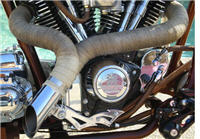Motorcycle Exhaust Tuning Information!
Our subscriber, Johnn Schroeder, asked an exhaust tuning question:
I've been told that there is a way to install a pin across an exhaust tube to create a reflected wave in the exhaust to create a 'tuned exhaust' where exhaust length is less important and custom exhausts can be created easier. Any truth to this technique? If so can you give us some idea of the math needed for tuning exhausts and how we iron hackers could duplicate them?
Answer:
There is a ton of information on motorcycle exhaust tuning.
Tuning a motorcycle exhaust is dependent on the tube diameter, length of tube and size of exhaust outlet from the engine, number of bends, etc.
We are not experts on this subject. I recommend reading the various information and calculators out there instead of trying to recommend something.
But I will give my two cents. The exhaust tuning is a factor of several variables (see links below for equations and calculators). The main variables are the exhaust outlet size from the engine, length of tube, size of tube, number of bends and diameter and size of bends.
Keep in mind that you are tuning the pressure and trying to reduce the resistance so that you can increase performance.
Adding a pin across the tube can have various effects. One thing is for sure that you are going to be reducing the surface area of the tube and hence creating additional drag. This could adversely affect your back pressure.
The other exhaust tuning and design theory is that this pin could disrupt the laminar flow and create turbulence. If this is what is going on, then your fluid speed would increase giving a positive effect.
This is extremely sensitive and requires an experienced computational fluid dynamics expert or aeronautical expert who knows how and where to place pins or fins to help create a positive effect from turbulence fluid flow.
If this is not designed correctly, the turbulent flow may have a negative effect and add unexpected vibrations and other unforeseen events. Sorry for not having any more specifics. Please see the following links for more info:
http://www.engr.colostate.edu/~allan/fluids/page7/page7f.html
http://bmwmotorcycletech.info/InExTuning.htm
http://en.wikipedia.org/wiki/Exhaust_system

